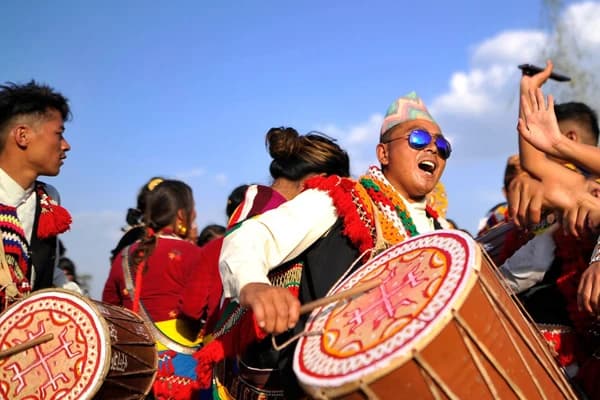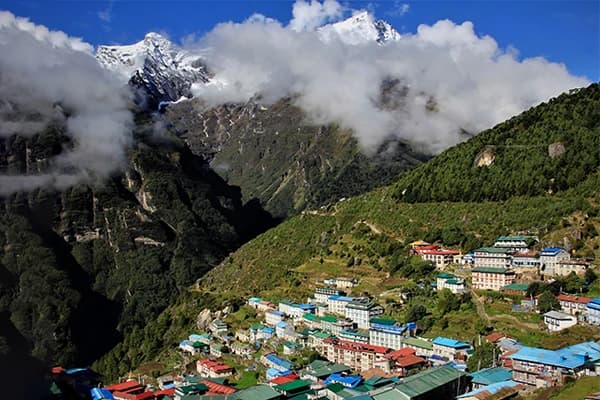Dingboche as the Best Acclimatization Spot
Below are the reasons why Dingboche is called the best acclimatization spot in everest region.
- Strategic altitude location
Dingboche is located at an ideal altitude of around 4,410 meters (14,470 feet which is perfect for those ascending to even higher altitudes like Lobuche and Everest base camp. Spending a day in the Dingboche village reduces the risks of the altitude-related problems.
- Optimal Acclimatization Activities
The Dingboche village offers several nearby hiking spots perfect for the acclimatization hikes and other activities. The popular acclimatization activities include hiking to Nangkartshang Peak (5,083 m) or to nearby valleys like Chukhung.
These hikes expose you to higher altitudes and help improve oxygen efficiency without overexertion. This activity also helps the body produce more red blood cells to carry oxygen more efficiently and reduce symptoms associated with altitude sickness.
- Comfortable climate and terrain
Dingboche is a village with temperate climatic conditions. It makes the village more comfortable to rest in. There is also less risk of extreme cold or harsh weather conditions there.
- Cultural and scenic appeal
Dingboche is a village inhabited by the Sherpa community. It offers the trekkers an opportunity to immerse themselves in the local culture, taste the unique cuisines, and experience their warm hospitality. These elements are good to build a positive attitude in the remote environment of the Everest region.
On the other hand, from Dingboche, you can see the stunning views of the snow-capped peaks like Ama Dablam, Lhotse, and Island Peak. It further enhances the trekking experiences.
- Amenities and infrastructure
In Dingboche, you can find several lodges and teahouses ranging from basic to more comfortable options. The room options include basic rooms without attached bathrooms or the comfortable rooms with ensuite bathrooms and hot showers. The dining rooms are cozy and offer nutritious mealsnd Wi-Fi at a reasonable rate.
Why does Dingboche stand out among other acclimatization spots on the trail?
The Dingboche is situated at the altitude level where trekkers can adjust safely to the thinner oxygen levels. It is important before ascending to the higher camps like Lobuche or Gorakshep.
The other acclimatization stop, like namche bazaar, is at a lower altitude level. It is the first acclimatization stop, but it is more like a bustling marketplace than a dedicated acclimatization hub. On the other side, the Lobuche is at a higher altitude close to Everest Base Camp and has harsh weather conditions.
As compared to both spots, the location and the altitude level of Dingboche maintain the balance between these two. So, Dingboche stands out among Namche Bazaar and Lobuche on the trail.
Things to Do During Acclimatization in Dingboche
- Explore the Sherpa culture and village life.
The Dingboche village is home to several monasteries, stupas, and traditional stone houses that reflect the Sherpa culture. There you can experience the unique culture, traditions, and hospitality.
The locals are also very friendly. They may tell you the stories that highlight their cultural identity. You can also gain some cultural insights, learn their way of living, and many more.
- Hike to Nangkartshang Peak.
Hiking to the Nangkartshang peak is a popular activity while in Dingboche. It takes around 3–4 hours to complete the trip. During and on the top, you can enjoy the stunning views of the mountains like mount everest, Lhotse, Makalu, and ama dablam.
It is popular also because it is based on the principle, “ hike higher & sleep lower.” It allows the body to adapt to the decreasing oxygen level at the higher altitudes.
- Explore Chukhung Valley and visit Chukhung Ri.
You can also explore the Chukhung Valley and visit the Chukhung Ri. It can be challenging to some trekkers. From the chhukung ri, you can see the stunning views of the snowcapped giants like Ama Dablam and Island Peak along with the Imja Valley vistas.
- Rest and relax in the teahouse or Visit the local monasteries and stone-walled fields.
Spending the time resting in the village’s teahouses, enjoying the local Sherpa foods, and preparing for the high-altitude trekking ahead can also be done during the acclimatization day in Dingboche.
Instead of hiking, you can also visit and explore the local monasteries and stone-walled fields in Dingboche. It allows you to relax and enjoy the peaceful environment. You can also get insights about the local culture and traditions from the monks at the monastery.
- Enjoy sunrise and mountain views.
From Dingboche, the mountain views can be seen clearly. You can wake up early in the morning and watch the stunning sunrise over the Himalayas. The environment becomes serene with cooler breezes and lovely at that time.
Tips for a Successful Acclimatization Day in Dingboche
- Follow the gradual ascent and descent strategy during the hike to the Nangkartshang peak.
- Stay hydrated during the hike to prevent altitude sickness and adapt to the higher elevations.
- Consume the carb-rich foods like dal, bhat, noodles, and Sherpa stews.
- Dress in layers to stay warm during the hikes and rest periods.
- Explore the Dingboche village also besides hiking.
- Explore the monasteries and get insights into the Tibetan Buddhist culture and traditions.
- Monitor your health symptoms like headache, dizziness, or shortness of breath. It could be the altitude sickness symptoms.
- Use the trekking poles when hiking to maintain stability on the rocky trails.
- Respect the local culture and traditions.
- Ask permission before capturing the photo of the locals.
Conclusion
Dingboche village is an important part of the Everest trekking journey because it serves as a prime acclimatization hub at an altitude of 4410 meters. It allows trekkers to rest and adjust to the thinning air, ultimately reducing the risk of altitude sickness, a serious concern on the Everest region treks.
Don’t rush Everest — acclimate right, trek smart. Let’s map out your ideal stopover.





